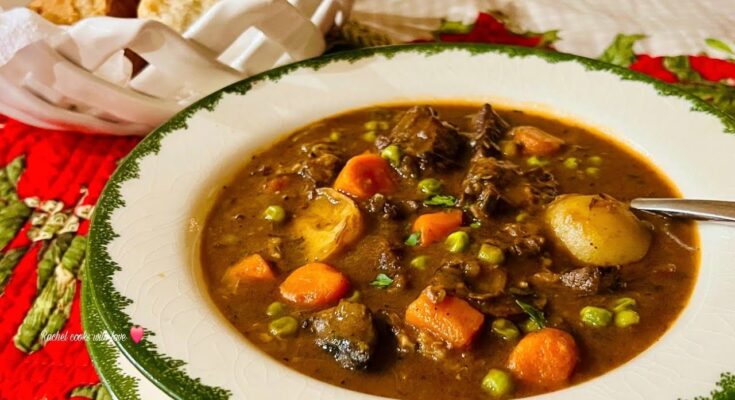Braised Beef Recipe: If there’s one dish that screams comfort and sophistication at the same time, it’s braised beef. Slow-cooked, melt-in-your-mouth tender, and packed with rich, deep flavors – this is the kind of meal that brings families together. Whether you’re making it for a special occasion or just want a hearty dinner, braised beef is a guaranteed winner.
What is Braised Beef?
Braising is a cooking technique that involves searing meat at a high temperature and then slowly cooking it in liquid. This method transforms tough cuts of beef into tender, flavorful bites. Think of it as a culinary slow dance – the kind where the meat and flavors get to know each other intimately over hours. It’s like turning an old, rugged pickup into a luxury ride.
What sets braised beef apart is the depth of flavor. The searing locks in juices, while the slow cook infuses every fiber with savory, aromatic goodness. It’s not just cooking; it’s crafting something special.
Why Braising Works for Beef
Braising is tailor-made for beef because it takes advantage of the meat’s natural composition. Many cuts that are too tough to grill or roast, like chuck roast or short ribs, have lots of connective tissue. When slowly simmered, that tissue breaks down into gelatin, which creates a silky texture and a rich, beefy taste.
And the best part? You can make braised beef on the stove, in the oven, or even in a slow cooker. Flexibility and flavor – what more could you want?
Choosing the Right Cut of Beef
Let’s get one thing straight: not all beef cuts are created equal. For braising, you want those hard-working, muscle-heavy cuts that get better the longer they cook.
Best Cuts for Braising
Here are your go-to cuts:
- Chuck Roast: The king of braising. Well-marbled and full of flavor.
- Short Ribs: Ideal for a luxurious dish – tender and fatty.
- Brisket: Slow-cooked to perfection, it’s incredibly flavorful.
- Shank: Lean but full of connective tissue that melts beautifully.
- Oxtail: Rich and gelatinous, perfect for deep flavor profiles.
These cuts are affordable and packed with potential. All they need is time, patience, and a bit of love.
How to Select Quality Beef
Choosing quality beef is crucial. Look for:
- Good marbling: Fat equals flavor. Those little white streaks mean juicy results.
- Bright red color: It shows freshness.
- Firm texture: Avoid mushy or slimy cuts.
- Trusted source: A reputable butcher or store ensures better meat and handling.
The better your beef, the better your braised dish will turn out. It’s worth investing a few extra bucks here.
Ingredients You’ll Need
You don’t need a ton of fancy ingredients to make great braised beef. But you do need the right ones.
Core Ingredients
Here’s what you absolutely must have:
- Beef (3-4 lbs)
- Salt and Pepper
- Olive Oil
- Onions
- Garlic
- Carrots
- Celery
- Tomato Paste
- Red Wine or Beef Broth
- Bay Leaves
- Thyme or Rosemary
These build the foundation of flavor. Think of them as your all-star team.
Optional Additions for Flavor Boost
Want to take it up a notch? Consider adding:
- Mushrooms for umami
- Parsnips or turnips for earthy notes
- A splash of balsamic vinegar for tang
- Crushed tomatoes for a tomato-forward twist
- Smoked paprika for depth
With these ingredients, your braised beef can be as simple or as elevated as you like.
Tools and Equipment
Good tools make the job easier—and the results tastier.
Must-Have Kitchen Tools
Before you get started, make sure you have:
- Sharp Chef’s Knife
- Cutting Board
- Measuring Cups & Spoons
- Tongs
- Wooden Spoon or Silicone Spatula
These basics will make prep and cooking more efficient.
Recommended Cookware for Braising
The right pot can make a big difference. Consider:
- Dutch Oven: The gold standard for braising—retains heat perfectly.
- Heavy-Bottom Pot: If you don’t have a Dutch oven, this will do.
- Slow Cooker or Instant Pot: Great for set-it-and-forget-it methods.
Make sure your pot has a tight-fitting lid. That’s key to locking in all that juicy steam and flavor.
Preparation Before Cooking
Here’s where the magic starts. Good prep = a great meal.
Cutting and Seasoning the Beef
First, cut the beef into large chunks if it isn’t already. About 2-3 inches each. Then pat it dry with paper towels—this helps you get that delicious crust when searing.
Season generously with salt and pepper. Don’t be shy; it’s the foundation of flavor.
Prepping Your Vegetables and Herbs
Next, chop your onions, carrots, and celery into even chunks. Mince the garlic. Strip the leaves from your herbs. You want everything ready to go because once the beef hits the pan, things move quickly.
Mise en place (everything in its place) is the key to stress-free cooking.
Step-by-Step Braising Process
Time to get cooking! Follow these steps and you’ll have a masterpiece.
Step 1: Sear the Beef
Heat olive oil in your Dutch oven over medium-high heat. Add beef chunks in batches—don’t crowd the pan. Sear until each side is golden brown. This step locks in flavor and gives the meat a beautiful crust.
Remove and set aside once seared.
Step 2: Deglaze the Pan
Add a splash of red wine or broth to the hot pot. Scrape up those brown bits (called fond)—they’re flavor gold! Let the liquid simmer for a few minutes to cook off the alcohol and concentrate the flavors.
Step 3: Add Aromatics and Liquid
Now it’s time to start building those deep, rich flavors. After deglazing the pan, toss in your chopped onions, carrots, celery, and garlic. Sauté them for about 5–7 minutes, or until they begin to soften and the onions turn translucent. Stir in a tablespoon or two of tomato paste. This adds a sweet umami punch and helps thicken the final sauce.
Once the vegetables are nicely caramelized, return the beef to the pot. Nestle it in so the meat is partially submerged. Add enough beef broth (or a mix of broth and red wine) to just cover the beef about three-quarters of the way. Then, drop in your bay leaves, rosemary, and thyme. Bring it all to a gentle simmer.
This is your flavor bath—it’s where the transformation begins. The meat will slowly soak up all those savory juices, becoming tender and succulent.
Step 4: Slow Cook Until Tender
Now for the easy part—letting time work its magic. Cover your Dutch oven and transfer it to a preheated oven at 300°F (150°C). Let it cook low and slow for about 2.5 to 3 hours. If you’re using a stovetop, keep it on low heat, maintaining a gentle simmer.
Check the beef after a couple of hours. You’ll know it’s done when you can easily shred it with a fork or it falls apart when gently prodded. If it’s not quite there, let it cook a bit longer.
The low, slow cooking process is what gives braised beef its signature texture—fork-tender and dripping with rich, complex flavors. The sauce will have thickened into a savory gravy that’s perfect for spooning over mashed potatoes, polenta, or even rice.
How to Know When It’s Done
Even though the timer may say it’s ready, your beef might still need a bit more TLC. Trust your senses here.
Texture and Tenderness Tips
The ideal braised beef should not resist your fork. If it feels even slightly tough or chewy, put the lid back on and let it cook for another 20–30 minutes. Tenderness is your number one indicator.
Stab a piece with a fork—if it pulls apart with almost no effort, it’s done. If not, patience will pay off. Remember, low and slow is the name of the game.
Temperature Guide
For those who love precision, the internal temperature of fully braised beef should hit around 195°F to 205°F (90°C to 96°C). This range ensures the connective tissue has fully broken down, delivering that melt-in-your-mouth experience.
Use a meat thermometer to check the thickest piece, but also judge by feel—especially if your cut has lots of collagen.
Serving Suggestions
Braised beef is more than just meat—it’s a meal. The key is pairing it with sides that complement its richness without overshadowing it.
Side Dishes that Pair Perfectly
Here are some killer combos to serve with your beef:
- Creamy Mashed Potatoes: A classic for a reason—soak up that gravy!
- Buttered Egg Noodles: Perfect for catching all the savory sauce.
- Polenta: Adds a smooth, buttery base.
- Roasted Root Vegetables: Sweet carrots, parsnips, and potatoes balance the beef.
- Crusty Bread: For mopping up every last drop of the sauce.
These pairings help stretch your dish further and bring balance to the richness.
Plating and Presentation Tips
Presentation doesn’t have to be complicated:
- Place a generous scoop of mashed potatoes or polenta on the plate.
- Layer shredded or whole beef chunks on top.
- Spoon the sauce over everything.
- Garnish with fresh herbs like chopped parsley or thyme.
This not only looks gourmet—it tastes like heaven.
Storing and Reheating Leftovers
Braised beef is one of those magical meals that tastes even better the next day. Proper storage and reheating will keep it just as delicious.
Best Practices for Storage
Let the beef cool to room temperature before storing. Then:
- Refrigerator: Store in an airtight container for up to 4 days.
- Freezer: Freeze in meal-sized portions with extra sauce for up to 3 months.
Label your containers so you know what’s inside and when it was made.
How to Reheat Without Drying
Here’s how to bring it back to life:
- Stovetop: Warm it slowly over medium-low heat, adding a splash of broth if needed.
- Oven: Place in a covered baking dish at 325°F (160°C) for 20–30 minutes.
- Microwave: Use low power in short bursts, stirring in between, and add liquid to keep it moist.
Always reheat gently to preserve that tender texture.
Common Mistakes to Avoid
Even the best cooks can slip up. Here’s how to avoid common braising blunders:
- Skipping the Sear: Searing creates a flavor-packed crust. Don’t skip it.
- Not Using Enough Liquid: The beef should be partially submerged—not floating or dry.
- Too High Heat: High temps dry out the meat. Keep it low and slow.
- Rushing the Process: Tender beef takes time. If it’s not ready, let it go longer.
- Crowding the Pan: When searing, give the beef space. Overcrowding leads to steaming instead of browning.
Avoid these pitfalls, and your braised beef will be next-level.
Health Benefits of Braised Beef
While braised beef is undoubtedly indulgent and comforting, it also comes with several nutritional perks—especially when balanced with the right ingredients and portion sizes.
Packed with Protein
Beef is a fantastic source of high-quality protein, essential for building and repairing tissues. A standard serving of braised beef can contain around 25-30 grams of protein, making it a great option for athletes, active individuals, and anyone looking to meet their daily protein intake.
Protein also helps you feel fuller for longer, which can assist with appetite control and weight management when eaten in moderation.
Rich in Iron and B Vitamins
One of the most notable health benefits of beef is its iron content, particularly heme iron, which is more easily absorbed by the body than plant-based iron. Iron is crucial for producing red blood cells and transporting oxygen throughout the body. Braised beef is also rich in B vitamins, especially B12, which supports nerve function and DNA synthesis.
These nutrients are vital for energy levels, cognitive function, and maintaining a healthy immune system.
Customizable for Healthier Eating
Braised beef doesn’t have to be heavy. You can:
- Trim excess fat from your meat before cooking.
- Use low-sodium broth to control salt intake.
- Add loads of vegetables for fiber, vitamins, and minerals.
- Serve with healthier sides like quinoa, brown rice, or steamed greens instead of mashed potatoes.
With thoughtful preparation, braised beef can be both delicious and nourishing.
Recipe Variations to Try
Once you’ve mastered the classic braised beef, why not mix it up? These variations can breathe new life into your kitchen routine.
Asian-Inspired Braised Beef
For a bold twist, use ingredients like:
- Soy sauce
- Ginger
- Garlic
- Star anise
- Hoisin or oyster sauce
This gives your beef a sweet, savory, and aromatic profile that pairs well with rice or noodles.
Mexican-Style Braised Beef
Think birria or barbacoa! Add:
- Dried chili peppers (like guajillo or ancho)
- Cumin
- Cinnamon
- Lime juice
Use it in tacos, enchiladas, or burrito bowls for a spicy, slow-cooked sensation.
Italian Braised Beef
Go Mediterranean with:
- Crushed tomatoes
- Oregano and basil
- Olives or capers
Serve over polenta or fresh pasta for an Italian dinner that feels like Nonna made it.
The beauty of braised beef is its adaptability—you can take it in any direction depending on your cravings and pantry staples.
FAQs about Braised Beef Recipe
1. Can I make braised beef in a slow cooker?
Absolutely! Just sear your meat and veggies beforehand, then transfer everything to the slow cooker. Cook on low for 8 hours or high for 4-5 hours. It’s a convenient, hands-off method with fantastic results.
2. Is it possible to overcook braised beef?
Yes—but only if you’re using lean cuts or cooking at too high a temperature. With the right cut (like chuck or short ribs) and a low simmer, it’s hard to go wrong. Just check it periodically to avoid drying it out.
3. Can I braise beef without wine?
Definitely. While wine adds depth, you can replace it with beef broth, balsamic vinegar, grape juice, or even a splash of apple cider vinegar for acidity.
4. What’s the difference between braising and stewing?
Both involve slow-cooking meat in liquid, but braising typically uses larger meat cuts and less liquid, while stewing uses smaller pieces submerged in more broth. Braising yields a thicker sauce; stews are soupier.
5. How do I thicken the sauce after braising?
Remove the lid for the last 30 minutes to let it reduce naturally, or stir in a slurry made from cornstarch and cold water. Another trick? Puree some of the cooked veggies into the sauce!
Conclusion
Braised beef is a beautiful fusion of technique, patience, and bold flavors. Whether you’re cooking for your family on a Sunday evening or planning a romantic dinner at home, this dish brings warmth and comfort to any table. From choosing the right cut to mastering the slow-cooking process, you now have the tools to create a restaurant-quality meal right in your own kitchen.
So grab that Dutch oven, let the aromas fill your kitchen, and treat yourself to a plate of fall-apart tender, soul-satisfying braised beef.



